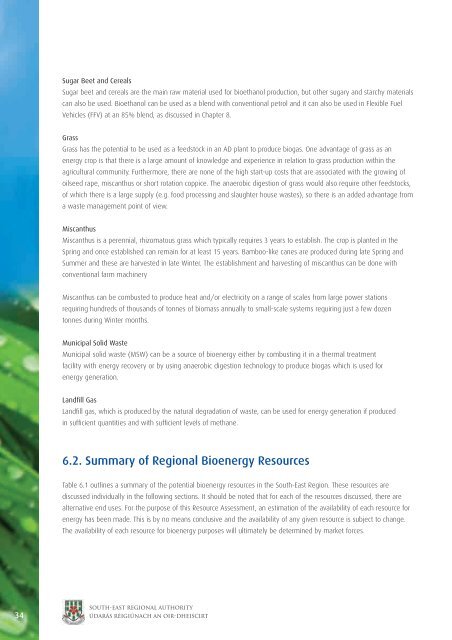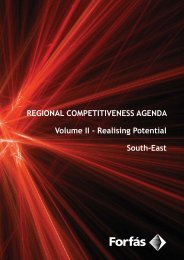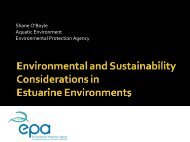Bioenergy Implementation Plan - South-East Regional Authority
Bioenergy Implementation Plan - South-East Regional Authority
Bioenergy Implementation Plan - South-East Regional Authority
You also want an ePaper? Increase the reach of your titles
YUMPU automatically turns print PDFs into web optimized ePapers that Google loves.
Sugar Beet and Cereals<br />
Sugar beet and cereals are the main raw material used for bioethanol production, but other sugary and starchy materials<br />
can also be used. Bioethanol can be used as a blend with conventional petrol and it can also be used in Flexible Fuel<br />
Vehicles (FFV) at an 85% blend, as discussed in Chapter 8.<br />
Grass<br />
Grass has the potential to be used as a feedstock in an AD plant to produce biogas. One advantage of grass as an<br />
energy crop is that there is a large amount of knowledge and experience in relation to grass production within the<br />
agricultural community. Furthermore, there are none of the high start-up costs that are associated with the growing of<br />
oilseed rape, miscanthus or short rotation coppice. The anaerobic digestion of grass would also require other feedstocks,<br />
of which there is a large supply (e.g. food processing and slaughter house wastes), so there is an added advantage from<br />
a waste management point of view.<br />
Miscanthus<br />
Miscanthus is a perennial, rhizomatous grass which typically requires 3 years to establish. The crop is planted in the<br />
Spring and once established can remain for at least 15 years. Bamboo-like canes are produced during late Spring and<br />
Summer and these are harvested in late Winter. The establishment and harvesting of miscanthus can be done with<br />
conventional farm machinery<br />
Miscanthus can be combusted to produce heat and/or electricity on a range of scales from large power stations<br />
requiring hundreds of thousands of tonnes of biomass annually to small-scale systems requiring just a few dozen<br />
tonnes during Winter months.<br />
Municipal Solid Waste<br />
Municipal solid waste (MSW) can be a source of bioenergy either by combusting it in a thermal treatment<br />
facility with energy recovery or by using anaerobic digestion technology to produce biogas which is used for<br />
energy generation.<br />
Landfill Gas<br />
Landfill gas, which is produced by the natural degradation of waste, can be used for energy generation if produced<br />
in sufficient quantities and with sufficient levels of methane.<br />
6.2. Summary of <strong>Regional</strong> <strong>Bioenergy</strong> Resources<br />
Table 6.1 outlines a summary of the potential bioenergy resources in the <strong>South</strong>-<strong>East</strong> Region. These resources are<br />
discussed individually in the following sections. It should be noted that for each of the resources discussed, there are<br />
alternative end uses. For the purpose of this Resource Assessment, an estimation of the availability of each resource for<br />
energy has been made. This is by no means conclusive and the availability of any given resource is subject to change.<br />
The availability of each resource for bioenergy purposes will ultimately be determined by market forces.<br />
34<br />
south-east regional authority<br />
údarás réigiúnach an Oir-DheisCIrt





